I complain a lot about the heavy clay-loam that comprises most of the soil that I have to garden in. There are plenty of wonderful plants that I have given up on as residents in my garden. However I’ve come to embrace those species which thrive here and seed about happily.
One such group of plants (that of special interest to me) are the Trilliums. As long time member of the GLC (Great Lakes Chapter of NARGS), I have benefited greatly from the generosity and guidance of many of our legendary members, most of whom are only with us in the wonderful plants they shared, and I am grateful for this memorable connection.
Decades ago, the GLCs’ sales tables as well as the generosity garden friends, were the only means one had to acquire these special plants found in our gardens today. The greatest driving force in both the dispersal and how to grow trilliums, rests with a pair of our chapter’s founding members; Roberta & Fred Case. To be sure other members contributed as well, but year in and year out most all of the trillium to appear in our Plant Sales, trace their histories back to the Case’s Garden and many of those went into the plant Auction. The bidding was always lively and quickly ascended to a point well beyond my comfort level.

The first trillium to appear in our gardens is the Snow Trillium, T. nivale. which is always snapped up whenever a division appears on our Club’s sales tables.
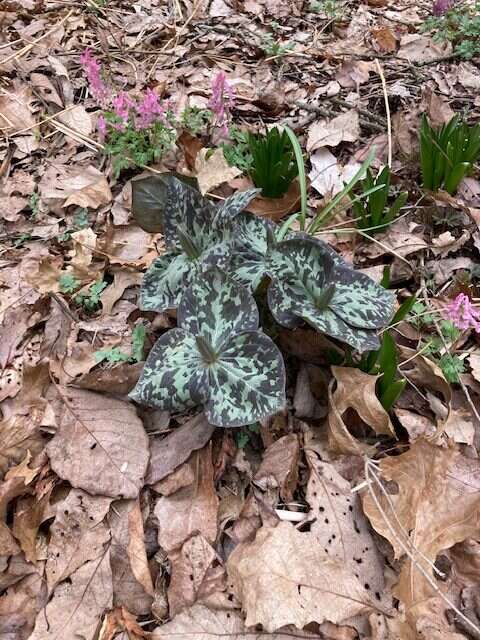
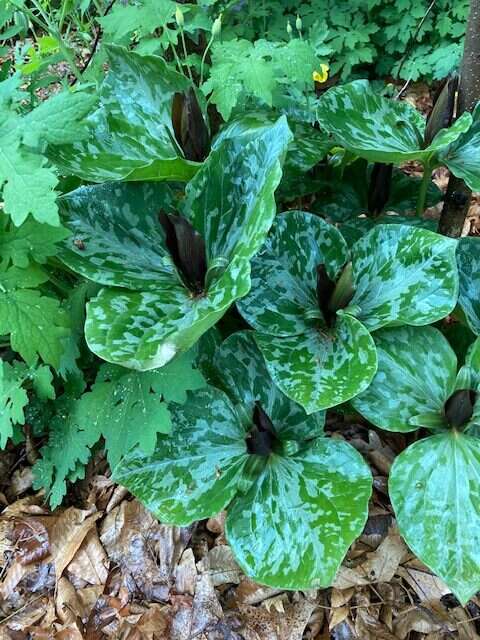
With each passing year they and their progeny, have increased and improved, some becoming quite spectacular in their own right with near black flowers,

But even before I had any success at the Sales my dear friend and mentor Dick Punnett, had shared countless numbers of the T. grandifloras that he considered near-weeds. So plentiful were these adaptable trillium, in the rich damp woods that made-up most of his one of a kind garden, that almost anytime he wanted to create a new bed he would first start by digging up a dozen or so and tossing them aside. I would gather them up, quick as I could or they’d die in the sun. They may have been weeds to him but they were nothing short of treasures to me. Better still the form that grew in his woods have a wonderful trait in that they quickly grew into sizable clumps.
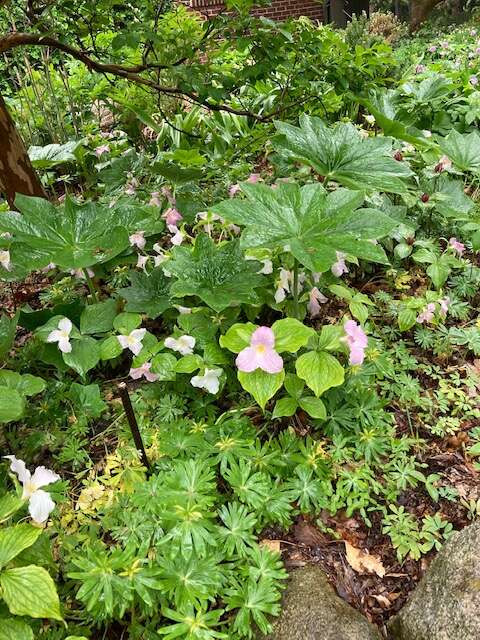
Today almost every woodland bed in our garden contains some of Dick’s Trillium grandifloras. They are the most plentiful trillium here, but I can’t bring myself to call them common.
Other members have contributed T. grandifloras as well to our clubs’ sales over the years, and I always took advantage of adding to the gene pool in the garden.

Whenever a local woodlot was about to be razed to make way for yet another sub-division, I would always make a quick search and if Trillium were present, a stop at the construction trailer to get permission to remove them was never refused.
A close second to T. grandiflora (in abundance in this garden), would have to be T. recurvatum. The prairie trillium is very happy to occupy sunnier edges of the woodland bed, even venturing out quite some distance into full sun.

There are several forms of trillium recurvatum in the garden. One is stoloniferous and makes massive patches with alarming rapidity, but when you’ve started with acres of empty space this was a plus as I could easily add it here and there and let it do it’s thing.
Other forms were later purchased from nurseries such as Arrowhead Alpines or Plant Delights.
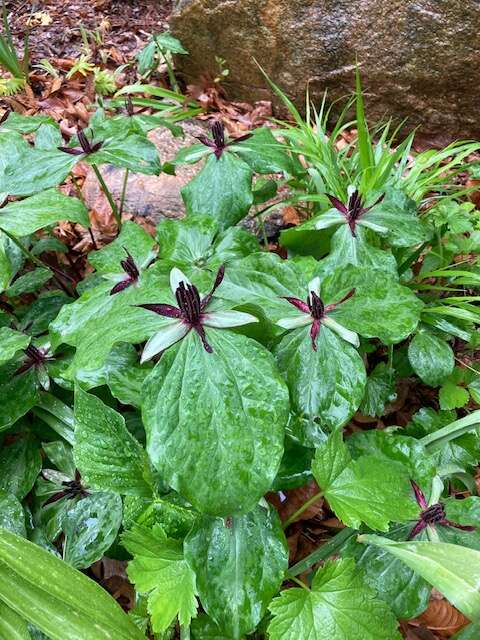
This is Trillium stamineum (another purchase from Arrowhead Alpines), it’s twisted petals distinguishes it from all other trillium. This spring I was surprised to find a single flowering stem over 200ft. away from what has become the original patch, the work of Yellow Jackets and wasps.

This plant remains a mystery to me. It was given to me by Bob Stewart on the day his shipment of trillium came in from a Southern wholesaler. Dick & I happened to be present the day the box arrived. When Bob opened the crate and there were three copies of a plant that looked very different from all of the others. Bob handed one of them to Dick, another to me and kept on for himself.
I planted mine in the garden and it made a clump of a dozen stems in short order. So I dug up and divided the clump, gave divisions to Don and Tony, and scattered the others through out the garden, but only 3 of my divisions survived the ordeal.
My first copy of the following trillium arrived via Southern acquaintance of Dicks, I remember his first name was Ewen but I cannot recall his last name.
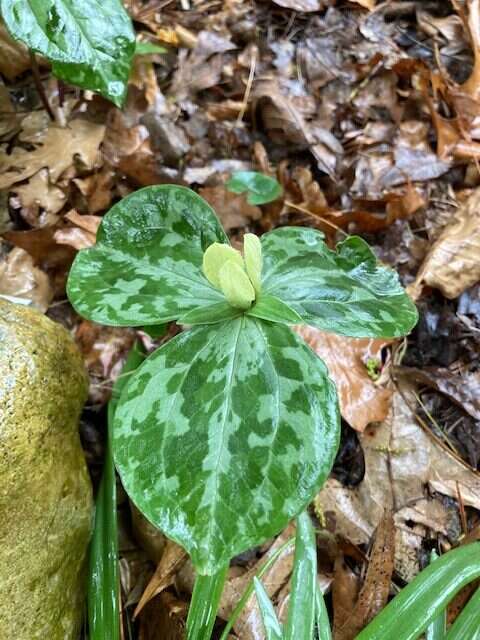
This little beauty is Trillium discolor. It had never set seed on its own so I’ve added several more courtesy of PDN.

These also came to be in our garden thanks to the folks at Plants Delight Nursery. Sadly the rain has muted its silvery sheen, and dulled its maroon blotches.
Trillium underwoodii according to the PDN, catalog hales from the dry Alabama woodlands, but has been a reliable performer here in my somewhat dry Michigan woodland bed. Which is more than I can say for T. decipiens, in three tries I have as yet to find a place to make that species happy.
Not too far away from the proceeding trillium, is a thriving clump of another mail-ordered trillium.
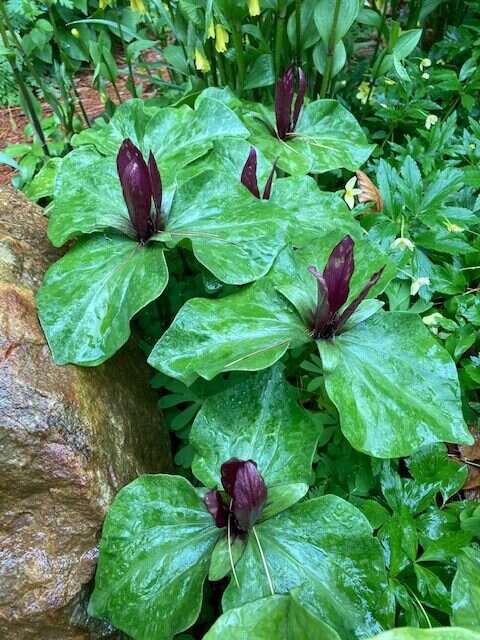

Trillium albidum arrived as gifts in an order from Natures Garden Nursery, a mail order nursery run by Frederick Held in Scio, Oregon. They have made the move East and slowly self sown seedlings appear here or there.
I can’t say the following Trillium sessile have seeded about…
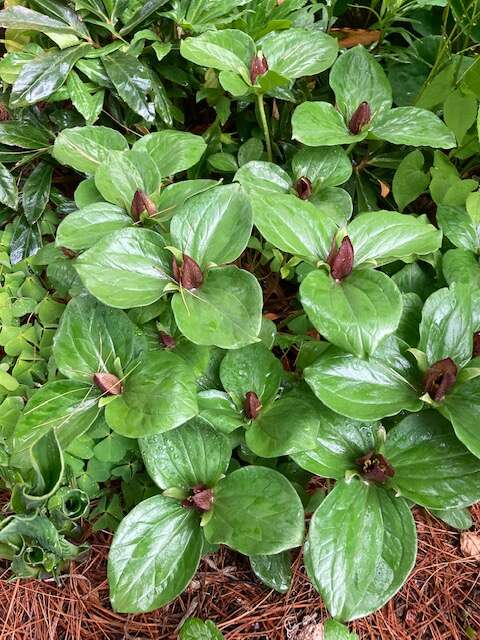
…the clumps of the forms I have seem amiable to division. There are at least 2 forms in the garden, one a GLC Sales purchase, the other a gift from Don La Fond.
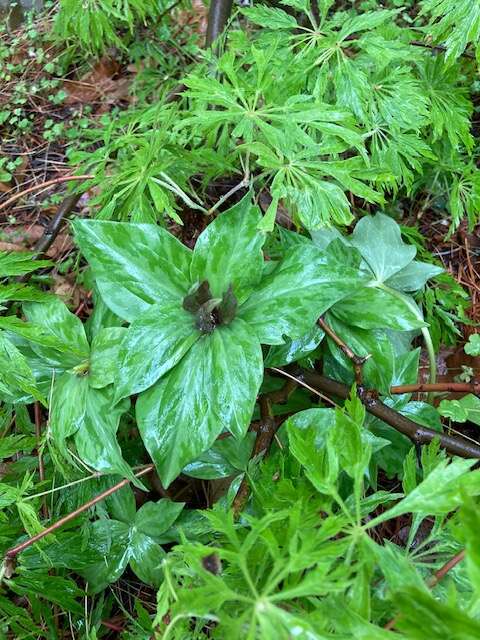
This unusual 6 leaved form of Trillium cuneatum arrived in the garden via a GLC Sales also. It was donated to the plant auction by Tony Reznicek, who acquired it from Ellen Horning’s ‘Senica Hill Nursery’.
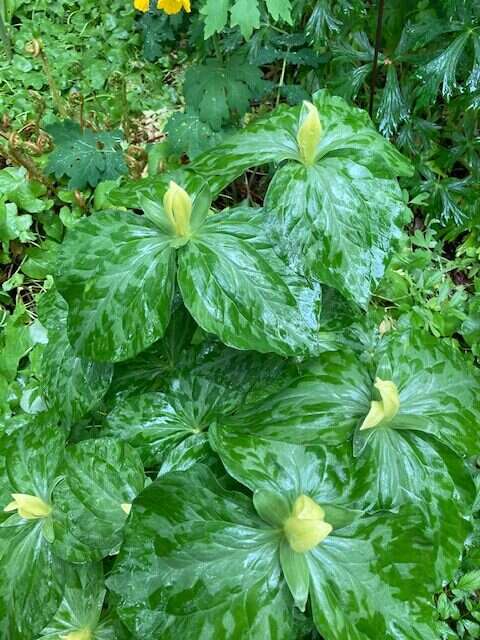
Another GLC Sales purchase (from long ago) was Trillium luteum. Very few seedlings have appear, however I believe the fault is mine, as these plants are located in an area with far too much, other plant competition for seedlings to survive.
I believe the trillium species with the third oldest longevity in our garden belongs to this cultivar of Trillium cernuum.
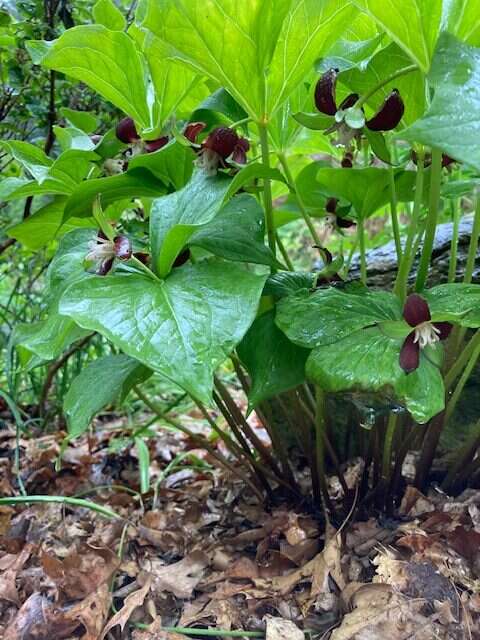
Decades ago Dick and I went to explore the long-ago, abandoned site of his garden mentor Bob Tucker. The property had been purchased by one of the Big Three Automobile Companies, but hadn’t fenced it in, nor razed the house or garden as yet. This was one of the few rescues from the Bull-dozer

A relatively, more recent purchase via a GLC auction, is this Trillium viridescens. The bidding was so intense between myself and another long-time GLC member (as well as a fellow fanatic of the genus, and dear soul to boot), I simply had to divide the clump to share it with her. I am really over-due in dividing this clump again.

An even more recent addition is this expanding clump of Trillium oostingii, which came to me via fellow, long-time GLC member, Bob Swartz. It is the only one of the more recently-discovered, Southern species that I’ve succeeded in finding the correct placement for in the garden, on the first try.
Within the past decade, I have been one of the very fortunate recipients to have been handed a 1-gallon, plastic zip-lock bag-full, of trillium seed heads that were gathered from the Case’s Garden. There was no telling what they were, but they were sure to be good. I sowed the seed from each capsule into t’sown 4″x4″ pot, and by the third year the pots were chock-full of multiple plants needing to be planted out. Dozens of pot-fulls went into the garden and dozens went onto the GLC Sales tables.


Not only have those pots yielded wonderful species but many hybrids as well, most of which had flowered so early I failed to capture their images. This year there are a second round of mixed-Case- seedlings ready for a place in the garden.

As special and wonderful as all of these species and hybrids are, the trilliums which stop visitors in their tracks are the double-flowered forms of T. grandiflora.

Some were gifts, one a rare plant auction win, others and perhaps my favorites were finds, while out roaming woodlots with very close friends.
All are quite unique.
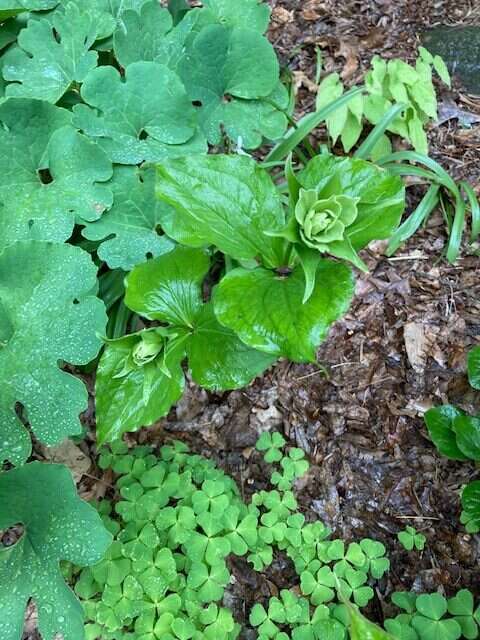
All of them need to be grown on, divided and shared.

In spite of my attempts, I have as yet failed in getting this green, single-flowered form to set seed.


Hopefully in the not too far future, they will make it into the trade.
In creating this post, I’ve failed to include not only nearly all of the hybrids, but several species as well. However I feel confident this post illustrates how these wonderful and growable woodland plants are, and deserve a place in our gardens.
